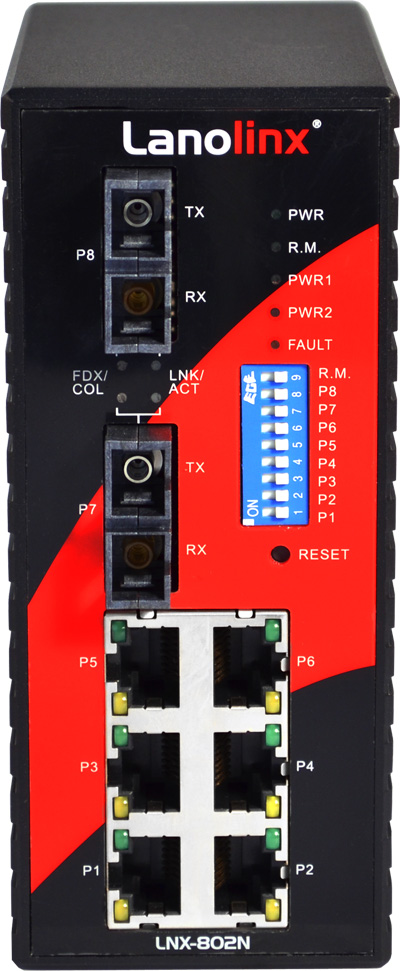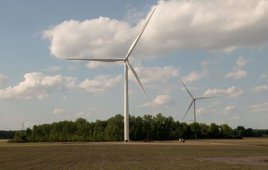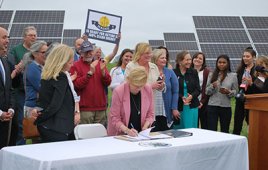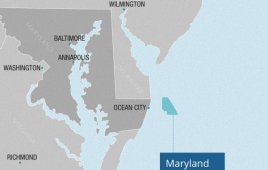
This diagram of a redundant wind-turbine network illustrates a serial-to-Ethernet converter, which controls and reports information from a wind tower’s PLC (programmable logic controller) to a central control station. This is done using a redundant fiber-optic network with industrial managed switches.
Brian Roth | Marketing Product Engineer | Antaira Technologies
The Bureau of Land Management’s latest statistics show wind power topping the charts as the fastest growing energy technology worldwide for just over a decade. These are impressive stats considering the competition for power generation from natural gas, traditional fossil fuels, and other renewable sources such as solar power. The continued growth of wind energy is also noteworthy given the unstable economy and uncertainty of government support via the PTCs or production tax credits.
The fact that wind power has excelled over the last 10 years is a testament to modern technology. Today technological advancements in turbines are seen in nearly every turbine component including the size of towers. Better equipment has allowed for taller turbines, some reaching heights of well over 100 meters with larger and lighter blades that are better able to access wind steams and generate power.
For turbines to develop so successfully in size and scope, advancements have also had to happen at a micro level. Because most large wind farms are in remote locations, the need to accurately control and monitor production from a distance is important and involves near-microscopic cables and wireless communication devices. Advanced monitoring equipment also lets wind operators make adjustments remotely and refine turbine production, which is critical considering the dynamic environment of a wind farm. Wind speeds are rarely the same from hour to hour let alone day to day.
Thanks to modern technology, serial device servers and managed Ethernet switches within a wind tower can collect and provide data from each turbine’s controller, gearbox, and anemometers at a wind farm for oversight at a more centrally located command center. An Ethernet switch is the central hub or network that connects devices to a computer network. The ideal Ethernet networking architecture for use at a remote wind farm is a fiber-optic ring.
More common bus-Ethernet communication systems provide another option, but they only work when wind-turbine communication systems are located in close proximity to each other. Fiber-optic cables have the advantage of creating a quick and reliable communication link over long distances, such as from a central control room to a remote wind farm. They transmit data almost noise-free and can do so at high bandwidths.

Antaira’s LNX-802NS3 is an industrial Ethernet switch with the redundant ring feature. By using fiber ports, it extends the connection distance that increases the network elasticity and performance, making it ideal for wind-power applications.
Fiber-optic cables use threads of glass that are as thin as a human hair to send data from one source to another. Each individual glass thread within the cable is capable of sending significant amounts of data via light waves. Using managed switches to form a fiber-optic ring architecture provides numerous advantages for a remote wind farm. There are four basic optical networks (including bus, star, ring, and collapsed backbone), but an optimum choice depends on the device’s networking requirements.
A ring topology tends to use less cabling while providing secure data redundancy. This means that a fiber-optic networking ring continually uses the same data pathway, preventing data loss to and from a wind farm despite the potential of a single link failure. For this reason, fiber-optic technology protects data from getting compromised due to electromagnetic interference generated by the wind turbine.
In addition, optical fiber is easy to handle. The fiber connectors can be terminated correctly in less than a minute and termination doesn’t require isolation or special tooling, making maintenance and field repairs a fairly simple task. Many wind-turbine-maintenance companies have even begun fiber-optic retrofits on older turbines.
The small size of fiber-optic cable does require expertise and special attention to ensure damage doesn’t occur when cutting cables during installation or wind-farm construction. Industrial-grade networking equipment is, therefore, a must for any wind-farm application. With a minimum of 100,000 hours as the mean time between failures, industrial-grade equipment offers the reliability of an extended lifecycle over commercial equipment.
Because wind farms face a wide variety of environments ranging from the hot deserts of Arizona to the cold plains of North Dakota, the durability of every turbine cable and component are essential to ongoing power production. Should any component require maintenance or repair, the sensitive circuitry in a turbine relies on a stable network for communication, ensuring that information quickly and accurately reaches the control room.
Although wind-farm environments are often extreme, they fit perfectly into the -40 to 75°C temperature range of operating industrial networking equipment including fiber-optic cables. The technology is also engineered to withstand the constant shock and vibration generated by the turbines, which might otherwise degrade and break solder joints of lower quality electrical production.
Today’s wind towers present unique networking challenges that require a mix of serial, Ethernet, fiber-optic, and wireless communication solutions. The benefits of remote monitoring let wind farm operators save substantial costs in time in site visits while optimizing power production from a distance. Advanced industrial-grade networking technology offers the degree of reliability and protection required to accurately collect data and monitor turbines to ensure a successful wind farm.
Filed Under: Uncategorized




